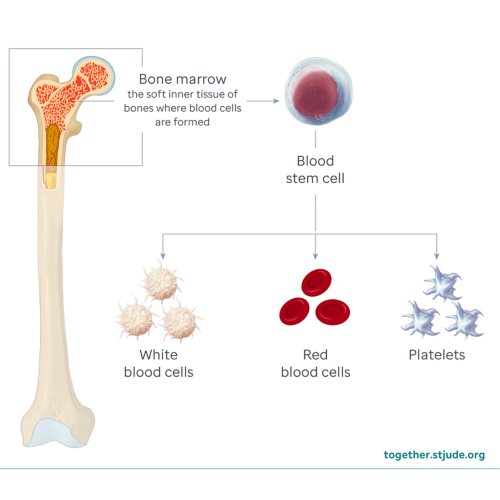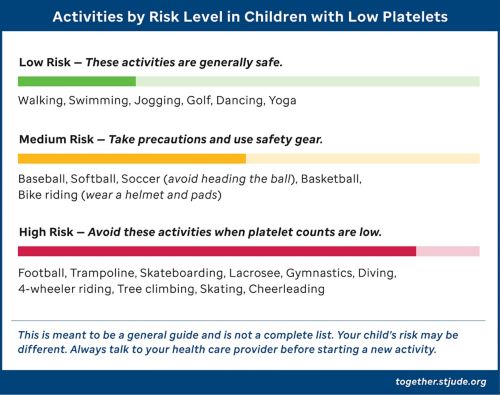Pancytopenia is a blood disorder where there is a decrease in all 3 types of blood cells: red blood cells, white blood cells, and platelets. This happens when something is wrong with the bone marrow, where blood cells are formed.
Conditions caused by the decrease in blood cell types include:
- Anemia: too few red blood cells
- Leukopenia: too few white blood cells
- Thrombocytopenia: low platelet count
Complications of pancytopenia may include serious infections, bleeding, and heart problems. If untreated, this disorder can be life threatening.
Pancytopenia has many possible causes. These include:
- Diseases such as cancer or bone marrow disorders
- Infections
- Medicine side effects
- Chemotherapy or radiation treatments
- Autoimmune disorders such as lupus
- Family history of blood disorders
- Environmental toxins, including radiation, benzene, or arsenic
In about half of pancytopenia cases, the cause is not known (idiopathic).
A person with pancytopenia can have a broad range of symptoms which can vary in frequency and severity. Symptoms may come on gradually or all at once.
Signs and symptoms of pancytopenia include:
- Weakness
- Fatigue
- Skin problems, such as rashes or easy bruising
- Pale skin
- Rapid heart rate
- Shortness of breath
- Bleeding problems, such as bleeding gums, nosebleeds, or internal bleeding
- Infections
These symptoms are more serious and require urgent medical care:
- A fever higher than 101°F (38.3°C) by mouth or 100°F (37.8°C) under the arm
- Seizures
- Convulsions
- Heavy bleeding
- Severe shortness of breath
- Confusion
- Loss of consciousness (passed out)
Diagnosis of pancytopenia
Pancytopenia is diagnosed based on your child’s medical history, physical exam, and lab tests. Your doctor may ask you about any changes in bleeding or bruising, recent illnesses, or medicines your child is taking.
Lab tests for pancytopenia may include:
Treatments for pancytopenia
Treatment for pancytopenia involves managing the complications of anemia, leukopenia, and thrombocytopenia as well as treating the underlying cause.
Identifying the root cause of pancytopenia is important for planning the right treatment. For example, if pancytopenia is caused by exposure to toxins, removing the toxins from the person’s environment may solve the problem.
Treatments for pancytopenia include:
- Medicines that stimulate the bone marrow to produce cells
- Medicines that suppress the immune system (if the immune system is thought to be attacking the bone marrow)
- A stem cell (bone marrow) transplant, which puts new stem cells into your child's body so they can create new blood cells
- Blood transfusions, such as getting red blood cells or platelets
- Watchful monitoring (for mild cases)
Prognosis for pancytopenia
The prognosis for pancytopenia varies widely depending on the severity of the condition and the underlying cause. Patients with pancytopenia can have serious complications, such as severe infections, bleeding, or heart problems.
Some patients may be cured with proper treatment. Other patients may need ongoing care and monitoring.
Children with pancytopenia may have frequent visits to the doctor and need hospital stays for health problems that occur.
Tips to help manage pancytopenia include:
Take steps to prevent infection: Wash hands often, keep patient areas clean, and stay away from people who are sick.
Don’t give your child any medicine without talking to your doctor: Some medicines can keep platelets from working properly and can increase the risk of bleeding. Talk to your care team before giving your child any medicine or supplement.
Alert others of your child’s condition: Be sure that others know about your child’s medical condition and know what to do if an accident or injury occurs. Tell all health care providers about your child’s diagnosis and any medicines they take. This is especially important before any medical or dental procedures.
Know what activities to avoid: If your child has fewer red blood cells, they may get tired more easily or get out of breath. Be sure your child does not overdo physical activity. When platelet counts are low, your child is at higher risk of bleeding. Your child should avoid contact sports, rough play, and activities that could involve falls or injury to the head or stomach.
Call your doctor or go to an emergency room right away if your child has any serious injury, especially one that involves any hit to the head or stomach.
When to call your care team
Call your health care provider if your child:
- Looks pale, has trouble breathing, or is more tired than usual
- Has skin or eyes that look yellow
- Has a fever at or above 101°F (38.3°C) by mouth or 100°F (37.8°C)
- Has other symptoms of illness or infection
- Bleeds easily or for too long after an injury
Questions to ask your care team


